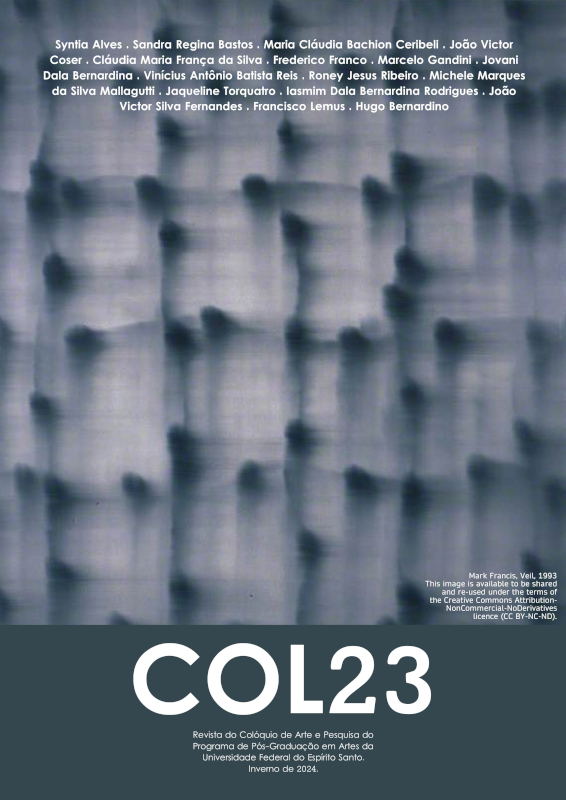The sertanejo from Os sertões in Deus e o diabo na terra do sol
reflections of the aesthetics of violence in a horizon of expectations
DOI:
https://doi.org/10.47456/col.v14i23.44181Keywords:
Os sertões, beatos e cangaceiros, horizonte de expectativas, Deus e o diabo na terra do sol, estética da violênciaAbstract
The premise of this work is to identify the reception of Euclidean epic work, highlighting the countryman approach, based on “Os Sertões” (1902), by Euclides da Cunha, considering the concept of horizon of expectations as presented by the aesthetics of reception, by Hans Robert Jauss. The research observes the horizon of expectations for the countryman, also blessed and cangaceiro, which resulted from the reception of Os Sertões (1902), and its strengthening in subsequent literary and non-literary works, until the middle of the 20th century. This horizon outlines an aesthetic for narratives (and characters) that adopt the backlands, mysticism and cangaço as their themes, including the study on hunger by Josué de Castro, “Geography of hunger”. In “God and the Devil in the Land of the Sun” (1964), the aforementioned horizon is altered by the aesthetics of violence.
Downloads
References
BARROS, Luitgarde Oliveira Cavalcanti. A derradeira gesta: Lampião e Nazarenos guerreando no sertão. 3ª ed. Rio de Janeiro: Mauad, 2018.
BENTES, Ivana. “Introdução”. In: ROCHA, Glauber. Cartas ao mundo. Org. Ivana Bentes. São Paulo: Companhia das Letras, 1997, p. 9-74.
BOSI, Alfredo. História concisa da literatura brasileira. 43. ed. São Paulo: Cultrix, 2006.
CALASANS, José. Cartografia de Canudos. Salvador: Secretaria de Cultura e Turismo, Conselho Estadual de Cultura, EGBA, 1997.
CANDIDO, Antonio. Literatura e sociedade. São Paulo: T.A Queiroz, 2000; Publifolha, 2000.
CASTRO, Josué de. Geografia da fome: o dilema brasileiro: o pão ou aço. Rio de Janeiro: Edições Antares, 1984.
CORDEIRO, Tarcísio Fernandes. Histórias de um trauma: memórias, testemunhos e ficção sobre a guerra de Canudos. 2020. 189 f. Tese (Doutorado em Letras) – Programa de Pós-graduação em Letras: Estudos Literários da Faculdade de Letras da Universidade Federal de Minas Gerais, Belo Horizonte, 2020. Disponível em <https://repositorio.ufmg.br/bitstream/1843/34294/1/Hist%c3%b3rias%20de%20um%20trauma%20-%20mem%c3%b3rias%2c%20testemunhos%20e%20fic%c3%a7%c3%a3o%20sobre%20a%20guerra%20de%20Canudos.pdf>. Acesso em 26 dez. 2021.
CUNHA, Euclides da. Os sertões. Edição crítica e org. Walnice Nogueira Galvão. 2ª ed. São Paulo: Ubu Editora/Edições SESC São Paulo, 2019a.
CUNHA, Euclides. “Nota preliminar”. In: CUNHA, Euclides da. Os sertões. Edição crítica e org. Walnice Nogueira Galvão. 2ª ed. São Paulo: Ubu Editora/Edições SESC São Paulo, 2019b, pp. 10-11.
FACÓ, Rui. Cangaceiros e fanáticos: gênese e lutas. 4ª ed. Rio de Janeiro: Editora Civilização brasileira, 1976.
GALVÃO, Walnice Nogueira. “Fortuna crítica”. In: CUNHA, Euclides da. Os sertões. 2ª ed. São Paulo: Ubu Editora/Edições SESC São Paulo, 2019c, pp. 616-633.
JAUSS, Hans Robert. A história da literatura como provocação à teoria literária. Tradução: Sérgio Tellaroli. São Paulo: Editora Ática S.A, 1994.
LIMA, Valdemar. “Em busca de uma fotografia participante. In: ROCHA, Glauber. Deus e o diabo na terra do sol. Rio de Janeiro: Editora Civilização Brasileira S.A., 1965b, pp. 15-25.
MONTELLO, Josué. “A origem de ‘Os sertões’”. Revista Brasileira, Fase VII, Jan. Fev. Mar., ano VIII, n. 30, 2002, pp. 9-18.
MONTENEGRO, Abelardo. Fanáticos e cangaceiros. Fortaleza: Gráfica Editora, 2011.
RÊGO, José Lins do. Pedra Bonita. Rio de Janeiro: GB, 1973.
ROCHA, Glauber. Deus e o diabo na terra do sol. Rio de Janeiro: Editora Civilização Brasileira, 1965.
ROCHA, Glauber. Deus e o diabo na terra do sol, 1964. Disponível em: https://www.youtube.com/watch?v=PGlsr-kpD1E. Acesso em 08 maio 2024.
ROCHA, Glauber. “Eztetyka da fome 65”. In: ROCHA, Glauber. Revolução do Cinema Novo. São Paulo: Cosac Naify, 2004, p. 63-67.
SIEGA, Paula Regina. O reflexo de Calibã no espelho de Próspero: estudo sobre a recepção italiana do Cinema Novo (1960-1970). 2010. 527 f. Tese (Doutorado em Línguas, Cultura e Sociedade) – Università Ca’ Foscari Venezia. Veneza, 2010. Disponível em: <http://dspace.unive.it/handle/10579/1043?show=full>. Acesso em 21 mar. 2024.
ZILBERMAN, Regina. Estética da recepção e história da literatura. São Paulo: Editora Ática, 1989.
Downloads
Published
How to Cite
Issue
Section
License
Copyright (c) 2024 Maria Cláudia Bachion Ceribeli

This work is licensed under a Creative Commons Attribution-NonCommercial-NoDerivatives 4.0 International License.
The authors of works submitted to Revista do Colóquio authorize their publication in physical and electronic media, solely for academic purposes, and may be reproduced as long as the source is cited. They attest to their originality, authorship and originality.

